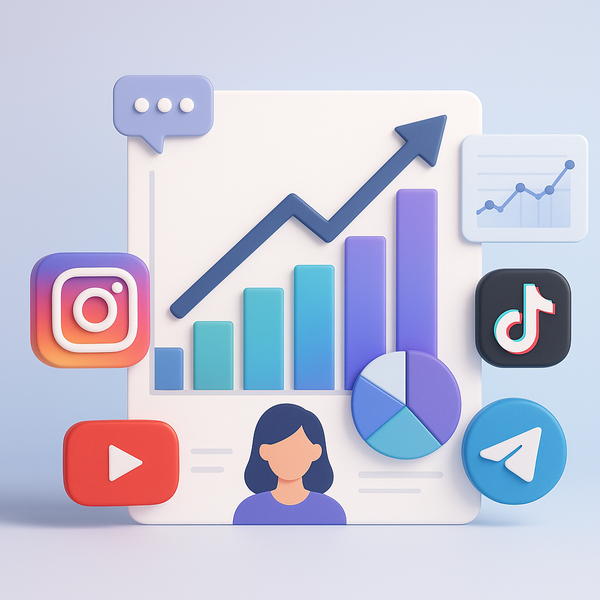The Psychology of Virality: Why Some Posts Go Viral and Others Don’t
On a random Tuesday morning, a 17-second video of a man sipping cranberry juice on a skateboard while lip-syncing to Fleetwood Mac turned into a global sensation. Within hours, Nathan Apodaca — aka @420doggface208 — had brands calling, media knocking, and millions watching. But why? What turns everyday content into digital wildfire? The answer lies deep in human psychology, and if you’re marketing on TikTok, Instagram, YouTube, or Telegram, it’s a principle you can’t afford to ignore.
The Anatomy of Viral Content
There’s no magic formula, but viral content often contains a blend of emotional triggers, relatability, and timing. If you reverse-engineer successful posts, patterns start to emerge:
- Emotionally Charged: Posts that evoke surprise, awe, laughter, or anger often travel faster and farther.
- Highly Shareable: Content that’s easy to remix, duet, or forward invites virality (think TikTok trends or Telegram meme chains).
- Narrative Arcs: Even a 10-second clip has a beginning, middle, and end. Stories stick—messages don’t.
"People don’t share facts, they share feelings." — Jonah Berger, author of Contagious: Why Things Catch On
Platform-Specific Virality
Understanding what triggers engagement on one platform doesn’t guarantee the same success on another. Each ecosystem has its own psychological currency:
Instagram: Curation and Identity
On Instagram, users craft a highly personalized brand identity. Content that goes viral here often reinforces individual aspiration—aesthetic reels, motivational quotes, or lifestyle snapshots that align with a “better self.”
- Use storytelling carousels to build emotional tension
- Hook users in the first 3 seconds of a reel
- Visuals matter more than ever—color psychology plays a role
TikTok: Discovery and Play
TikTok is rooted in emergent behavior. Users are there to discover, remix, and innovate. Trends often start from raw, unfiltered content that feels authentic and unexpected.
According to data from Crescitaly's dashboard, TikTok videos that feature user participation—challenges, duets, reactions—see up to 4x engagement rates compared to passive formats.
YouTube: Authority and Retention
YouTube’s algorithm favors long-form trust. Viral videos here either ride a wave of curiosity (e.g., “I Lived Like Elon Musk for a Week”) or provide massive value in a short time (“5 Tricks to Grow on YouTube in 2024”).
Creators who study watch-time psychology—using hooks, pacing, and tension-release cycles—reap the rewards.
Telegram: Scarcity and Exclusivity
Telegram thrives on insider dynamics. Whether it’s a crypto trading signal or a limited-time drop from a creator, virality here is built on FOMO and perceived access to privileged information.
To go viral on Telegram:
- Leverage exclusive access (think “members-only” invites)
- Use mini-viral loops: tease > announce > deliver > amplify
- Optimize your channel preview—first impressions count
Psychological Triggers That Spark Sharing
Behind every viral post lies a cognitive lever. Here are five of the most powerful:
1. Social Currency
People share things that make them look good, smart, funny, or “in the know.” Think memes that make you laugh out loud—or niche TikToks that prove your depth in a subculture.
2. Emotion vs. Information
Neuroscientists have shown that emotional content activates the amygdala (your brain’s urgency switch). Meanwhile, dry facts rarely trigger reaction. To make your educational content go viral, wrap it in a personal story.
3. Novelty Bias
We’re wired to notice what’s new. That’s why unboxing videos, new feature drops, and “you’ve never seen this hack” formats crush on YouTube and Instagram.
4. Community Identity
Humans crave belonging. Content that signals alignment with a tribe—whether it’s gamer culture, wellness moms, or sneakerheads—spreads rapidly inside those circles.
5. Triggers and Timing
A post connected to current events, trending audio, or a cultural moment rides waves instead of rowing upstream. Using Crescitaly.com’s advanced panel, creators can schedule coordinated drops around these trigger points, ensuring peak exposure.
What About the Posts That Don’t Go Viral?
For every overnight success, there are thousands of solid posts that underperform. It’s not always about quality—it’s often about psychological friction:
- Too slow to hook attention (users scroll in milliseconds)
- No built-in reason to share (e.g., no social clout or relatability)
- Lack of emotion or authenticity (overly polished kills connection)
This is where creators and marketers benefit from measuring not just likes, but behavioral metrics. Tools like Crescitaly surface these signals—from retention drops to engagement dips—helping you iterate with data, not just instinct.
Conclusion: Mastering the Human Algorithm
Virality is not about chasing trends—it’s about understanding human nature. Whether you’re launching an indie album on YouTube, a fitness brand on Instagram, or a meme-forward Telegram community, the most successful content amplifies emotion, identity, and story.
In 2024 and beyond, expect viral mechanics to grow more nuanced. Algorithms will continue to prioritize watch time and engagement signals, but the real gains will come from creators and brands who build psychological resonance into their content by design, not luck.
As you plan your next content drop or tweak your SMM strategy, remember: you’re not creating for an algorithm—you’re creating for a brain. And neuroscience outperforms guesswork every time.
Meta Title: Psychology of Viral Content in Social Media
Meta Description: Unlock what makes content go viral on Instagram, TikTok, YouTube, and Telegram. The psychology of shareability, backed by platform data.
Tags: psychology of virality, social media marketing, TikTok trends, Instagram engagement, YouTube growth, Telegram strategy, SMM panel, Crescitaly





